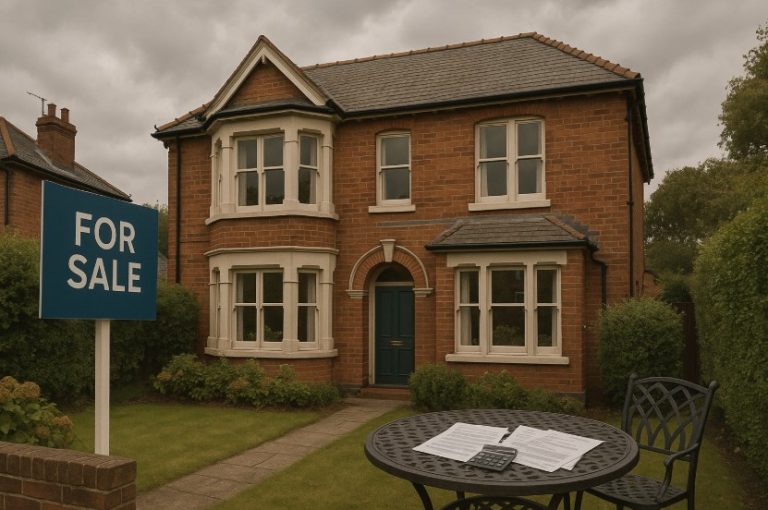Transferring the ownership of a house doesn’t always involve a sale or estate transaction. In the UK, it’s common for homeowners to change property titles for reasons such as gifting, inheritance planning, divorce, or tax management.
Understanding the legal frameworks and procedures behind how to transfer ownership of a house without selling is essential for avoiding pitfalls and ensuring compliance with HM Land Registry requirements.
In this guide, we explore the key methods, legal documents, and tax considerations that come with property ownership transfers—without a sale.
What Is the Legal Process to Transfer Property Ownership in the UK?

In the UK, transferring property ownership without a sale involves legally updating the property’s title through HM Land Registry. This can be done for various personal or financial reasons.
While no money changes hands in the sense of a sale price, the transfer still requires formal documentation and may have legal or tax implications.
There are two primary legal mechanisms:
- Transfer of equity: Used when part of the property ownership is transferred, such as when someone is added or removed from the title.
- Deed of gift: Used when full ownership is gifted to someone else, often a family member.
The transfer becomes legally binding once registered with HM Land Registry using specific forms and procedures, which typically involve a solicitor or conveyancer.
Why Might Someone Transfer Property Ownership Without Selling?
There are several common motivations for transferring ownership of a house without selling it:
- Gifting property to a child or relative as part of estate planning
- Divorce or separation settlements that involve dividing property
- Adding a spouse or partner to the deeds for joint ownership
- Tax planning strategies to reduce inheritance tax exposure
- Changing ownership structures in business or investment contexts
Each reason can dictate the method of transfer, potential taxes, and legal responsibilities involved.
What Are the Legal Methods to Transfer House Ownership Without a Sale?
In the UK, there are several legally recognised ways to transfer ownership of a house without selling it. The appropriate method will depend on the relationship between the parties involved, the reasons for the transfer, and whether or not the property is mortgaged. Understanding each legal route ensures the process is completed correctly and avoids unintended financial or legal consequences.
1. Deed of Gift (Gifted Transfer)

A Deed of Gift is a legal document used when a property is transferred voluntarily without any exchange of money. This method is most commonly used to gift property to a child, spouse, or other close family member.
Key characteristics of a deed of gift:
- The gift is made without any financial consideration (i.e., no payment is received).
- The transfer must be unconditional and permanent.
- If the donor continues to live in the property without paying rent, it may still be treated as part of their estate for Inheritance Tax
Important legal points:
- The donor must be of sound mind and not under any duress or coercion.
- Both parties may need to provide evidence that the gift was willingly made.
- Although gifting avoids selling, legal fees, Land Registry costs, and potential tax liabilities can still apply.
This method should be handled with a solicitor’s assistance, as it carries long-term legal and tax implications, particularly if the donor requires care later in life.
2. Transfer of Equity

A Transfer of Equity involves adding or removing a person from the ownership of a property. It is often used in the following situations:
- One partner transfers part of the property to a spouse after marriage.
- One party is removed from the property following a divorce or separation.
- A parent adds a child to the property deeds as part of succession planning.
Unlike a full property transfer, equity transfers allow partial ownership changes and are suitable when a mortgage is involved.
Key steps:
- Obtain mortgage lender’s approval if the property is mortgaged.
- Agree on how much equity (ownership share) is being transferred.
- Sign the TR1 form and any lender-required documents.
- Pay Stamp Duty Land Tax if the share being transferred is valued over the threshold or if mortgage debt is taken on.
A transfer of equity is legally binding once registered with HM Land Registry, and it requires professional legal handling, especially when financial liabilities are involved.
3. Declaration of Trust (Trust Deed)

A Declaration of Trust, or Trust Deed, is used when two or more people want to record different ownership shares in a property, especially where financial contributions are unequal. This is often used when:
- A parent provides a deposit for their child’s house purchase.
- Partners want to define unequal shares in a jointly owned property.
- Someone contributes to a property they do not live in.
While this method doesn’t technically change the legal ownership on the title, it does create a beneficial ownership agreement that can be enforced legally.
Important features:
- Sets out each party’s rights and responsibilities.
- Protects investments in case of dispute or sale.
- May be required by mortgage lenders when complex ownership structures are involved.
A Declaration of Trust complements the ownership registered with HM Land Registry and ensures clarity in legal proceedings or inheritance situations.
4. Tenancy Structure Modification

Properties owned by two or more people can be held as Joint Tenants or Tenants in Common. Changing from one structure to the other may not transfer ownership itself, but it can significantly affect how property is dealt with after death or in disputes.
- Joint Tenancy means both owners have equal rights and the property automatically passes to the surviving owner on death.
- Tenants in Common allows owners to have separate, defined shares and to leave their portion of the property to someone else in a will.
The change in ownership structure is made using a form SEV (Form of Severance), submitted to HM Land Registry.
Reasons to modify tenancy structure:
- Estate planning or to protect inheritance rights.
- Formalising unequal ownership arrangements.
- Divorce or separation situations.
Although no financial consideration is involved, altering the tenancy structure still requires legal documentation and proper registration.
5. Use of Trusts for Property Transfer

Creating a family trust or discretionary trust allows property ownership to be transferred for the benefit of someone else, often used in high-value estates or long-term asset protection strategies.
Trusts allow:
- Control over how and when the property is used or sold.
- Protection from creditors or family disputes.
- Tax management over multiple generations.
However, trusts are legally complex and must be professionally drafted by a solicitor or trust specialist. They require formal registration and can have tax implications depending on the type and structure of the trust.
Legal Methods for Transferring House Ownership Without Selling:
| Method | Suitable For | Legal Documents Involved | Key Considerations |
| Deed of Gift | Gifting to children or relatives | TR1, AP1, ID1 | Inheritance Tax, CGT for non-residential |
| Transfer of Equity | Adding/removing someone from the title | TR1, AP1, Mortgage approval | SDLT may apply, mortgage lender’s consent |
| Declaration of Trust | Defining ownership shares | Trust Deed, TR1 (if changing title) | Beneficial ownership, dispute resolution |
| Tenancy Structure Change | Adjusting ownership structure for planning | Form SEV, TR1 (if needed) | Does not transfer ownership, affects succession |
| Property Trust | Long-term estate planning | Trust Deed, HMRC registration | Requires legal advice, complex tax rules |
How Can You Transfer Property Ownership Step by Step in the UK?
The ownership transfer process includes several important steps and forms. Here is a step-by-step guide:
- Inform the mortgage lender if there is an existing mortgage. Their consent is mandatory.
- Hire a solicitor or conveyancer to ensure all paperwork is properly completed and legally binding.
- Complete the TR1 form, which identifies the parties involved and specifies the nature of the transfer.
- Fill in the AP1 form, used to update the Land Registry’s official record.
- Provide ID verification through an ID1 form if not using a solicitor.
- Pay any necessary Land Registry fees, which are calculated based on the property’s value or mortgage size.
- Submit all documents to HM Land Registry for registration.
Here’s a simple table summarising the key forms and their purpose:
| Form | Purpose | Required For |
| TR1 | Transfers property ownership | All ownership transfers |
| AP1 | Updates Land Registry with new ownership | Registration of ownership change |
| ID1 | Identity verification if no legal rep | Used when acting without a solicitor |
| RX1 (optional) | Removes restrictions on title | Needed in certain legal scenarios |
What Are the Costs and Taxes When Transferring Ownership Without Selling?
Even when no money changes hands, some costs may still apply. These costs vary depending on the property value, whether a mortgage exists, and whether any tax thresholds are triggered.
Typical Costs Include:
- Solicitor or conveyancer fees: Usually between £200 and £1,000 depending on complexity
- Land Registry fees: Range from £40 to £910 depending on the value of the property or mortgage
- Stamp Duty Land Tax (SDLT): Not usually payable unless equity or mortgage debt is involved
- Capital Gains Tax (CGT): Can apply if the property is not the primary residence
- Inheritance Tax (IHT): If the original owner dies within seven years of gifting, the property’s value may be included in their estate
Here’s a table outlining potential tax obligations:
| Tax Type | Trigger Condition | Applies To |
| Stamp Duty Land Tax | If mortgage or money changes hands | Equity transfers, spousal transfers |
| Capital Gains Tax | On transfer of second homes or rental units | Gifting investment properties |
| Inheritance Tax | If donor dies within 7 years of the gift | Estate planning transfers |
What Should You Know About Gifting Property and Tax Implications?
Gifting property is a popular method of transferring ownership, particularly between parents and children. However, it carries financial risks and tax obligations.
- Inheritance Tax (IHT): Gifts made within seven years of the donor’s death may be taxed as part of the estate. This is known as the “7-year rule.” If the donor survives more than seven years, the gift becomes exempt from IHT.
- Capital Gains Tax (CGT): While gifting a main residence is generally exempt, CGT can apply when gifting rental properties or second homes. The property’s market value at the time of the gift is used to calculate potential gain.
- Deprivation of Assets: If an individual gives away their property and then applies for means-tested care, the local authority may investigate whether the gift was made to avoid paying for care. If so, the gift can be treated as part of their assets.
To reduce complications, consider the following precautions:
- Always formalise gifts with legal documents
- Maintain clear records of the property’s value at the time of gifting
- Consult both a solicitor and financial advisor before proceeding
How Can You Transfer Property Ownership Between Spouses or Civil Partners?

Property transfers between married couples or civil partners are common and relatively straightforward. These transfers are typically exempt from SDLT and CGT, making them a popular choice for updating property ownership for tax efficiency or estate planning.
Such transfers can take the form of:
- Full ownership change from one partner to another
- Joint ownership through adding a spouse to the title
- Alteration in shares if owned as tenants in common
The mortgage lender must approve the change if there is an outstanding mortgage, and the Land Registry must be notified using the TR1 and AP1 forms.
These types of transfers are especially beneficial because they do not trigger immediate tax liabilities, offering both flexibility and simplicity for couples managing joint assets.
How Can You Transfer a House to Children or Other Family Members?
Transferring property to children is often part of long-term inheritance planning. However, it must be approached with caution to ensure it is legally valid and tax-efficient.
Key Considerations:
- If the transfer is done as a gift, it must be unconditional and legally documented.
- The donor must understand that gifting property removes their control or ownership rights unless a trust is created.
- If the property is rented out, CGT may be due based on the market value at the time of transfer.
- If the parent continues living in the house without paying full market rent, the gift may not qualify for inheritance tax exemption.
Trusts can also be used to transfer property while maintaining some control. These arrangements can be complex and require specialist legal advice. A solicitor can help set up a family trust or discretionary trust to safeguard property rights while facilitating tax planning.
Is It Necessary to Hire a Solicitor for Property Ownership Transfers?
While it’s possible to complete a property transfer without legal representation, it’s generally not recommended unless the situation is very simple and straightforward. Errors in form completion or misunderstanding tax liabilities can result in long-term consequences.
A solicitor or licensed conveyancer can:
- Ensure compliance with Land Registry rules
- Assist in completing legal documents like TR1, AP1, and any declarations of trust
- Provide advice on SDLT, CGT, and IHT
- Liaise with mortgage lenders if the property is financed
Using a legal expert adds upfront cost but significantly reduces the risk of complications during and after the transfer.
Conclusion
Transferring ownership of a house without selling is a viable option for many UK homeowners looking to gift property, update ownership structures, or manage their estates. By understanding the legal routes available—such as deeds of gift, transfers of equity, and spousal exemptions—and engaging with legal professionals, individuals can ensure the process is smooth and compliant with HM Land Registry standards.
Whether motivated by family planning, tax strategy, or personal change, transferring house ownership without selling can be straightforward with the right guidance and documentation.
FAQs About Transferring Property Ownership in the UK
What forms are required to transfer property ownership in the UK?
Typically, the TR1 and AP1 forms are needed. If you’re not using a solicitor, the ID1 form is also required for identity verification.
Is a solicitor necessary for gifting a house to family?
While not mandatory, it’s highly advisable to use a solicitor to avoid legal and tax pitfalls.
Can you transfer a mortgaged property without selling?
Yes, but your mortgage provider must approve the change. This might involve a new mortgage application.
Are there any tax-free ways to transfer house ownership?
Yes. Spousal transfers and gifts below certain thresholds may be tax-free, though conditions apply.
How does HM Land Registry process a TR1 form?
Once submitted with supporting documents and fees, the Land Registry updates the title register, typically within a few weeks.
What are the implications of transferring a house as part of estate planning?
It can reduce inheritance tax liabilities but may still attract CGT or require a declaration of trust.
Can property ownership be transferred through a will before death?
No. A will only takes effect upon death. Ownership changes before death require a formal transfer.






